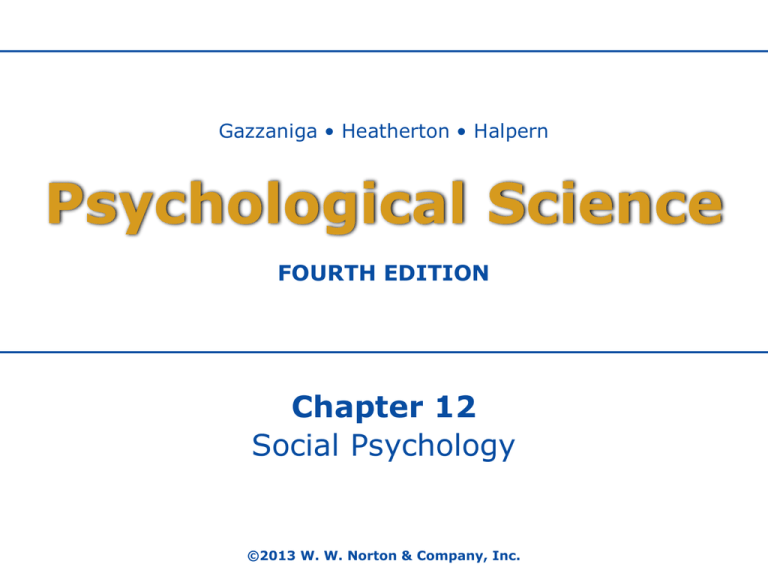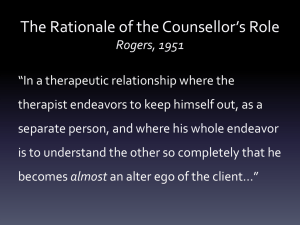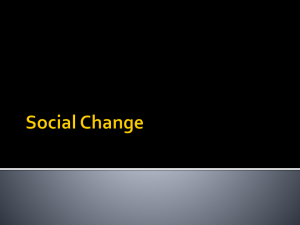
Gazzaniga • Heatherton • Halpern
Psychological Science
FOURTH EDITION
Chapter 12
Social Psychology
©2013 W. W. Norton & Company, Inc.
Chapter 12: Social Psychology
• What happened at Abu Ghraib?
• The case of Abu Ghraib challenges many
commonsense notions about human nature and
forces us to consider questions about humanity’s
dark side
• Is something wrong with people who humiliate,
beat, rape, torture, and murder others?
• Or are they just normal people caught up in
overwhelming situations that shape their
actions?
12.1 How Do We Form
Our Impressions of Others?
• Identify the goals of social psychology.
• Discuss the role that nonverbal behavior plays in
impression formation.
• Define the fundamental attribution error and the
actor/observer discrepancy.
• Describe the functions and self-fulfilling effects of
stereotypes.
• Distinguish between prejudice and discrimination.
• Distinguish between ingroups and outgroups.
• Discuss strategies to inhibit stereotypes and reduce
prejudice.
“Show Your Pride”
Scientists are finding more and more that different types of
nonverbal communication have consistent defining characteristics.
As this ScienCentral News video reports, researchers hope this will
lead to a way to improve human communication.
How Do We Form
Our Impressions of Others?
• Social psychology is concerned with how
people influence other people’s thoughts,
feelings, and actions
• We constantly make social judgments and
automatically classify people into social
categories
• Social psychologists have shown that our longterm evaluations of people are heavily
influenced by our first impressions
Nonverbal Actions and Expressions
Affect Our First Impressions
• How you initially feel about others will be determined
mostly by their nonverbal behavior (i.e., facial
expressions, gestures, mannerisms, and movements)
• Thin slices of behavior: Seconds-long observations offer
powerful cues for impression formation
– Participants viewed soundless 30-second film clips of college
teachers lecturing and then were asked to rate the lecturers’
teaching ability
– Ratings corresponded very highly with the ratings given by
the instructors’ students (Ambady & Rosenthal, 1993)
“Voting Influence”
Researchers have discovered that where you vote can influence
how you vote. They found that images that surround you, what
consumer researchers call “cues,” could influence your decisions.
Facial Expressions
• The first thing we notice about another person is
the face
– Human babies less than an hour old prefer to look
at and will track a picture of a human face rather
than a blank outline of a head (Morton & Johnson,
1991)
• The face communicates information such as
emotional state, interest, and distrust
• Eye contact is important in social situations,
though how we perceive it depends on our
culture
We Make Attributions About Others
• We constantly try to explain other people’s
motives, traits, and preferences
• Attributions: explanations for events or actions,
including other people’s behavior
• We are motivated to draw inferences in part by
a basic need for both order and predictability
• Just World hypothesis: When bad things
happen to people, we make sense of it by
blaming the victim—victims must have done
something to justify what happened to them
Attributional Dimensions
• Fritz Heider distinguished between two types of
attributions:
– Personal/internal or dispositional attributions: refer to
things within people, such as abilities, moods, or efforts
– Situational/external attributions: refer to outside events,
such as luck, accidents, or the actions of other people
• Bernard Weiner noted that attributions can vary on
other dimensions:
– They can be stable over time (permanent) or unstable
(temporary)
– They can be controllable or uncontrollable
Attributions About the Self
• We tend to have a self-serving bias in making
attributions about our own behavior:
– We attribute our failures to situational, unstable, or
uncontrollable factors in a way that casts us in a positive light
– We attribute our successes to personal, permanent factors in
a way that gives us credit for doing well
• Example: If you fail a test, you may blame your poor
performance on your not getting enough sleep or on the
professor’s creating a bad exam; if you do well on a test, you
may attribute that good performance to your being smart
Attributional Bias
• People tend to be systematically biased when they
process social information
• Fundamental attribution error: pervasive tendency to
overemphasize the importance of personality traits
and underestimate the importance of a situation when
explaining another’s behavior
– Began as the correspondence bias: We expect others’
behavior to correspond with their beliefs and personalities
• Actor/observer discrepancy: When interpreting our
own behavior, we tend to focus on situations; when
interpreting other people’s behavior, we tend to focus
on dispositions
Stereotypes Are Based
on Automatic Characterization
• Stereotypes: cognitive schemas that help us organize
information about people on the basis of their
membership in certain groups
– Allow for easy, fast processing of social information
– Occur automatically, largely outside of our awareness
– Affect impression formation
• Stereotypes are self-maintaining: They direct our
attention toward information that confirms them and
away from disconfirming evidence
– subtyping: When we encounter someone who does not fit a
stereotype, we put that person in a special category rather
than alter the stereotype
Self-Fulfilling Effects
• Self-fulfilling prophecy: tendency to behave in ways that
confirm our own or others’ expectations
– Teachers’ expectations of students’ success/failure can impact
those students’ performances (Rosenthal & Jacobson, 1968;
McKown & Weinstein, 2008)
– Women performed more poorly on a math test when they were
initially reminded of their sex (Shih, Pittinsky, & Ambady, 1999)
• Effects of stereotype threat reflect three interrelated
mechanisms:
– physiological stress
– thinking about one’s performance is distracting
– suppressing negative thoughts/emotions requires a great
deal of effort
Stereotypes Can Lead to Prejudice
• Stereotypes may be positive, neutral, or negative
• Negative stereotypes can lead to:
– prejudice: negative feelings, opinions, and beliefs
associated with a stereotype;
– discrimination: inappropriate and unjustified
treatment of people as a result of prejudice
• Why do stereotypes lead to prejudice and discrimination?
– Personality factors
– People treat others as scapegoats to relieve stress
– People discriminate against others to protect their own selfesteem
– We favor our own groups and stigmatize those who pose
threats to our groups
Ingroup/ Outgroup Bias
• Groups to which we belong are ingroups; those to which
we do not belong are outgroups
– Outgroup homogeneity effect: Once we categorize others as
ingroup or outgroup members, we tend to view outgroup
members as less varied than ingroup members
– Ingroup favoritism: We are more likely to distribute resources to
ingroup members than to outgroup members. We are more
willing to do favors for ingroup members and to forgive their
mistakes or errors.
• Evolutionarily, personal survival has depended on group
survival. Keeping resources within a group while denying
resources to outgroup members may have provided a
selective advantage.
Stereotypes and Perception
• Stereotypes can influence basic perceptual processes:
– White participants looked at pictures of either tools or guns
and were asked to classify them as quickly as possible.
Immediately before seeing a picture, participants were
shown a picture of a white face or a black face; they were
told that the face was being shown to signal that either a gun
or a tool would appear next. Being shown a black face led the
participants to identify guns more quickly and to mistake
tools for guns (Payne, 2001).
– Priming people with pictures of weapons (e.g., guns and
knives) leads them to pay greater attention to pictures of
black faces than to pictures of white faces (Eberhardt, Goff,
Purdie, & Davies, 2004)
Inhibiting Stereotypes
• We can consciously alter our automatic stereotyping
• Presenting positive examples of admired black individuals (e.g.,
Denzel Washington) produced more-favorable responses toward
African Americans (Dasgupta & Greenwald, 2001)
• Training people to respond counter-stereotypically —having
them press a “no” key when they saw an elderly person paired
with a stereotype of the elderly — led to reduced automatic
stereotyping (Kawakami, Dovidio, Moll, Hermsen, & Russin,
2000)
• Telling people that their test scores indicate that they hold
negative stereotypes can motivate people to correct their
beliefs, and the worse they feel about holding those beliefs, the
harder they try not to be biased (Monteith, 1993)
• In everyday life, inhibiting stereotyped thinking is difficult
and requires self-control
Cooperation Can Reduce Prejudice
• In working together toward a greater purpose, people
can overcome intergroup hostilities
• Social psychology suggests strategies for promoting
intergroup harmony and producing greater tolerance for
outgroups:
– Sherif et al. (1961): “Robber’s Cave” study showed that
introducing superordinate goals reduced hostility between
groups
– People who work together to achieve a common goal often
break down subgroup distinctions as they become one larger
group (Dovidio et al., 2004)
– Bilingual instruction in schools leads to less ingroup
favoritism among elementary school children (Wright &
Tropp, 2005)
Jigsaw Classroom
• Programs that most successfully bring groups together
involve person-to-person interaction
• Eliot Aronson’s jigsaw classroom:
– Students work together in mixed-race or mixed-sex groups in
which each member of the group is an expert on one aspect
of the assignment and then return to their own groups and
teach the material to their team members
• More than 800 studies of the jigsaw classroom have
demonstrated that it leads to more-positive treatment
of other ethnicities and that students learn the
material better and perform at higher levels
12.2 How Do Attitudes Guide Behavior?
• Explain how attitudes are formed.
• Identify characteristics of attitudes that are
predictive of behavior.
• Distinguish between explicit and implicit
attitudes.
• Describe cognitive dissonance theory.
• Identify factors that influence the
persuasiveness of messages.
• Describe the elaboration likelihood model.
How Do Attitudes Guide Behavior?
• Attitudes: people’s evaluations of objects, of
events, or of ideas
• Attitudes are shaped by social context, and
they play an important role in how we
evaluate and interact with other people
We Form Attitudes through
Experience and Socialization
• People tend to develop negative attitudes about new
things more quickly than they develop positive attitudes
about them (Fazio, Eisner, & Shook, 2004)
• Mere exposure effect: The more we are exposed to
something, the more we tend to like it (Zajonc, 1968;
2001)
• Attitudes are acquired via classical conditioning (e.g.,
advertisers associate products with celebrities) and
operant conditioning (e.g., rewarding a student for
studying may create a positive attitude toward studying)
• Attitudes are also shaped through socialization (e.g.,
would you eat a worm?)
Behaviors Are Consistent
with Strong Attitudes
• Stronger, more personally relevant attitudes are more
likely to predict behavior
– Someone who grew up in a strongly Democratic household is
more likely to register as a Democrat and vote Democratic
than someone who grew up in a more politically neutral
environment
• Attitude specificity: The more specific the attitude, the
more predictive it is
• Attitudes formed through direct experience tend to
predict behavior better
• Attitude accessibility: Easily activated attitudes are more
stable, predictive of behavior, and resistant to change
Attitudes Can Be Explicit or Implicit
• Explicit attitudes: attitudes that a person can
report
• Implicit attitudes: attitudes that influence a
person’s feelings and behavior at an
unconscious level
– People higher in self-reported (explicit) prejudice
were indeed less likely to vote for Obama
– People who reported low levels of prejudice but
whose scores on an implicit measure indicated
negative attitudes about blacks were also less
likely to vote for Obama (Payne et al., 2010)
Discrepancies Lead to Dissonance
• Cognitive dissonance: an uncomfortable mental
state due to a contradiction between two attitudes
or between an attitude and a behavior
– Example: People experience cognitive dissonance when
they smoke even though they know that smoking might kill
them
• People reduce dissonance by changing their attitudes
or behaviors; they sometimes also rationalize or
trivialize the discrepancies
Postdecisional Dissonance
• Dissonance arises when a person holds positive
attitudes about different options but has to choose
one of the options
– Example: A person might have trouble deciding which
college to attend; the person might narrow the choice to
two or three alternatives and then have to choose
• Postdecisional dissonance: motivates the person to
focus on one school’s — the chosen school’s —
positive aspects and the other schools’ negative
aspects
• Effect occurs automatically, with minimal cognitive
processing, and apparently without awareness
Insufficient Justification
• One way to get people to change their
attitudes is to change their behaviors first,
using as few incentives as possible
– Participants performed an extremely boring task
and then reported to other participants on how
enjoyable it was
– Participants who were paid more ($20) to lie
about their experience reported enjoying it less
than those paid less ($1) to lie (Festinger &
Carlsmith, 1959)
Justifying Effort
• When people put themselves through pain,
embarrassment, or discomfort to join a group,
they experience a great deal of dissonance
• To resolve the dissonance they inflate the
importance of the group and their
commitment to it
• This justification of effort helps explain why
people are willing to subject themselves to
humiliating experiences such as hazing
Attitudes Can Be Changed
through Persuasion
• Persuasion: the active and conscious effort to change an
attitude through the transmission of a message
• Factors affecting the persuasiveness of a message
include: source (who); content (what); receiver (whom)
• Elaboration likelihood model: a theory of how persuasive
messages lead to attitude changes
– Central route: motivated/able to process information. Use of rational
cognitive processes leads to strong attitudes that last over time and
that people actively defend
– Peripheral route: not motivated/able to process information.
Minimal processing of the message; leads to more impulsive action
12.3 How Do Others Influence Us?
• Define social facilitation, social loafing,
deindividuation, group polarization, and
groupthink.
• Differentiate between conformity, compliance,
and obedience.
• Identify factors that increase or decrease
conformity, compliance, and obedience.
How Do Others Influence Us?
• To fit in, we display our best behavior and try
not to offend others; we conform to group
norms, obey commands made by authorities,
and are easily influenced by others in our
social groups
• The desire to fit in with the group and avoid
being ostracized is so great that under some
circumstances we willingly engage in
behaviors we otherwise would condemn
Social Facilitation
• Social facilitation: The presence of others
enhances performance (Triplett, 1897)
• Zajonc’s (1965) model expands on Triplett’s,
predicting that social facilitation can enhance
or impair performance:
– If the dominant response is relatively easy, the
presence of others will enhance performance
– If the dominant response is difficult, the presence
of others will impair performance
Social Loafing
• Social loafing: People work less hard when in a group
than when working alone
– Six blindfolded people wearing headphones were told to
shout as loudly as they could. Some were told they were
shouting alone and others were told they were shouting
with other people. Participants did not shout as loudly
when they believed that others were shouting with
them(Latané, Williams, & Harkins, 1979).
• When people know that their individual efforts can
be monitored they do not engage in social loafing
Deindividuation
• People sometimes lose their individuality when
they become part of a group
• Deindividuation: a state of reduced individuality,
reduced self-awareness, and reduced attention to
personal standards
– Self-awareness typically causes people to act in
accordance with their values and beliefs; when
self-awareness disappears, so do restraints
– People are especially likely to become
deindividuated when they are aroused and
anonymous and when responsibility is diffused
(e.g., rioting by fans)
Group Decision Making
• Being in a group influences decision making in complex
ways
• Risky-shift effect: Groups often make riskier decisions
than individuals (Stoner, 1961)
• Subsequent research showed that groups sometimes
become more cautious
• Group polarization: The initial attitudes of group
members determine whether the group becomes riskier
or more cautious
• Groupthink: is an extreme form of group polarization
that results when group members are particularly
concerned with maintaining the group’s cohesiveness
We Conform to Others
• Conformity: altering one’s behaviors and
opinions to match those of other people or to
match other people’s expectations
• Why we conform:
– Normative influence: occurs when we go along
with the crowd to avoid looking foolish
– Informational influence: occurs when we assume
that the behavior of the crowd represents the
correct way to respond
Social Norms
• Social norms: expected standards of conduct
• Research consistently has demonstrated that people
tend to conform to social norms:
– Adolescents conform to peer pressure to smoke; jury
members go along with the group rather than state their
own opinions; people stand in line to buy tickets instead
of “cutting in”
• When do people reject social norms?
– Conformity varies with group size (Asch, 1956)
– Presence of a dissenter threatens group unanimity
• Groups tend to enforce conformity: Those who fail to go
along are rejected (Schachter, 1951)
“Shy Brains”
Some of us never talk to strangers at a party, while others like to
work the room. As this ScienCentral News video reports,
psychologists can see the signature of shyness imprinted in the
brain, in toddlers as well as in twenty-year-olds.
Social Norms Marketing
• Can the power of social norms be harnessed to
modify behavior in positive ways?
• College posters with messages such as, “Most
students have fewer than four drinks when they
party”
• May actually increase drinking among light drinkers
(Russell, Clapp, & Dejong, 2005)
• Adding a message that the behavior is undesirable
might help prevent social norms marketing from
increasing the behavior it is meant to reduce
(Schultz, Nolan, Cialdini, Goldstein, & Griskevicius,
2007)
We Are Compliant
• Compliance: the tendency to agree to do
things requested by others
• Factors that increase compliance include:
– Being in a good mood
– Failure to fully consider options
• Compliance strategies:
– Foot-in-the-door effect
– Door in the face
– Low-balling strategy
We Are Obedient to Authority
• The Milgram studies in obedience
• Milgram’s research demonstrated that
ordinary people may do horrible things when
ordered to do so by an authority
• A recent replication found that 70 percent of
the participants were obedient up to the
maximum voltage in the experiment (Burger,
2009)
12.4 When Do We Harm
or Help Others?
• Identify biological, situational, and
sociocultural determinants of aggression.
• Discuss the association between steroid use
and aggression.
• Review evolutionary explanations for altruism.
• Review explanations for the bystander
intervention effect.
When Do We Harm or Help Others?
• Humans help and hurt each other
• This tension between our aggressive and
altruistic sides is at the core of who we are as
a species
• Psychologists have provided much insight into
the roles that nature and nurture play in these
fundamental human behaviors
Many Factors
Can Influence Aggression
• Aggression: any behavior that involves the intention
to harm someone else
• Among humans, physical aggression is common
among young children but relatively rare in adults
• Adults’ aggressive acts more often involve words or
other symbols meant to threaten, intimidate, or
emotionally harm others
• Aggression can be considered across the levels of
analysis, from basic biology to cultural context
Biological Factors
• Stimulating or damaging the septum, amygdala, or
hypothalamus regions in the brain leads to corresponding
changes in the levels of aggression displayed
– Removing the amygdalas of normally very aggressive rhesus
monkeys caused them to become tame (Klüver & Bucy, 1937)
– Behavior associated with damage to this region is now
referred to as Klüver-Bucy syndrome
• In monkeys, enhanced serotonin activity lowered
aggression; interference with serotonin increased
aggression (Raleigh, McGuire, Brammer, Pollack, &
Yuwiler, 1991)
• In humans, low levels of serotonin have been associated
with aggression in adults and hostility and disruptive
behavior in children (Kruesi et al., 1992)
“Monkey Talk”
Researchers have discovered that some monkeys process the
sounds of the other monkeys much as people process language.
As this ScienCentral News video reports, it’s a discovery that
may lead to a better understanding of how people acquire the
ability to communicate.
Situational Factors
• Whether someone behaves aggressively
depends on the situational context
• Frustration-aggression hypothesis: The extent to
which people feel frustrated predicts the
likelihood that they will be aggressive (Dollard &
Miller, 1939)
• Cognitive-neoassociationistic model: Frustration
leads to aggression by eliciting negative
emotions (Berkowitz, 1990)
Social and Cultural Factors
• An evolutionary approach to aggression would call for
similar patterns of aggressive behavior to exist in all
human societies
• Violence varies dramatically across cultures and even
within cultures at different times
– Over the course of 300 years, Sweden went from being violent
to non-violent; this cultural change did not correspond with a
change in the gene pool
– Murder rates are far higher in some countries than in others
– In the United States, physical violence is much more prevalent
in the South than in the North
• Culture of honor: belief system in which men are primed
to protect their reputations through physical aggression
Steroids May Play a Role
in Some Violent Behavior
• “’Roid rage” has been used as a defense in murder cases
– Taking steroids might increase testosterone to such a level that the
hormone produces an extreme need for dominance and control,
which, in turn, provokes violent behavior
• Aggressive men, such as violent criminals, and particularly
physical athletes, such as hockey players, have been found
to have higher levels of testosterone than other males
(Dabbs & Morris, 1990)
• Research shows a modest correlation between testosterone
and human aggression
• Testosterone may be the result — rather than the cause —
of aggressive behavior
Many Factors
Can Influence Helping Behavior
• Prosocial behavior: acting for the benefit of others
• Why are humans prosocial?
– Selfless: motivated by empathy
– Selfishness: to relieve one’s negative mood
– Inborn tendency to help others
• Altruism: helping when it is needed without any apparent
reward for doing so
– From an evolutionary perspective, altruistic helping of others with
shared genes (kin selection) is beneficial (inclusive fitness)
– Through helping non-relatives, altruistic animals may also increase
the likelihood that other members of the social group will
reciprocate when needed (reciprocal helping)
Some Situations Lead
to Bystander Apathy
• Kitty Genovese was murdered while walking home
from work in New York City
• Witnesses to the crime reportedly did nothing to help
• Bystander intervention effect: the failure to offer help
by those who observe someone in need
• Research indicates four major reasons:
– Diffusion of responsibility
– People fear making social blunders in ambiguous situations
– People are less likely to help when they are anonymous and
can remain so
– People weigh the costs versus benefits of helping
12.5 What Determines
the Quality of Relationships?
• Identify factors that influence interpersonal
attraction.
• Distinguish between passionate and
companionate love.
• Discuss the function of idealization in
romantic relationships.
• Identify interpersonal styles and attributional
styles that contribute to relationship
dissatisfaction and dissolution.
“Mating Trick”
Any man who thinks he planned something clever for
Valentine’s Day should consider the ingenuity of the male
Australian cuttlefish. As this ScienCentral News video reports, it
sometimes disguises itself as a female in order to get the girl.
What Determines
the Quality of Relationships?
• The term relationships refers to connections
with friends and romantic partners
• Until the last decade or so, psychologists paid
little attention to how people select either their
friends or their romantic partners
• Researchers have now made considerable
progress in identifying the factors that lead us
to form relationships
Situational and Personal Factors
Influence Friendships
• There are a number of factors that promote
friendships, including:
– Proximity: how often people come into contact
• Proximity might have its effects because of
familiarity: People like familiar things more
than unfamiliar ones
Birds of a Feather
• People similar in attitudes, values, interests,
backgrounds, and personalities tend to like
each other
• Matching principle: The most successful
romantic couples also tend to be the most
physically similar
Personal Characteristics
• People tend to especially like those who have
admirable personality characteristics and who
are physically attractive
• Least likable characteristics are dishonesty,
insincerity, and lack of personal warmth. Most
likeable characteristics are kindness,
dependability, and trustworthiness
(Anderson, 1968).
Physical Attractiveness
• How people rate attractiveness is generally consistent
across all cultures (Cunningham, Roberts, Barbee, Druen,
& Wu, 1995)
– A computer program combined (or “averaged”) various faces
without regard to individual attractiveness. As more faces were
combined, participants rated the “averaged” faces as more
attractive (Langlois & Roggman, 1990).
– Other research shows averaged attractive faces are rated more
favorably than averaged unattractive faces (Perrett, May, &
Yoshikawa, 1994)
– Most people find symmetrical faces more attractive than
asymmetrical ones
• Attractiveness can bring many important social benefits
• The “what is beautiful is good” stereotype
Love Is an Important Component of
Romantic Relationships
• Passionate love: a state of intense longing and sexual
desire
• Companionate love: a strong commitment to care
for and support a partner
• In most enduring relationships, passionate love
evolves into companionate love (Sternberg, 1986)
• Adult relationships also vary in their attachment
styles (Hazan & Shaver, 1987)
• The attachment style a person has as an adult
appears to be related to how the person’s parents
treated her or him as a child (Fraley & Shaver, 2000)
Love is Fostered by Idealization
• People who fall in love and maintain that love tend to
be biased toward positive views of their partners
• Research (Murray et al., 1996) with couples showed
that:
– People who loved their partners the most also idealized
their partners the most;
– People with the most positively biased views of their
partners were more likely to still be in the relationships
with their partners several months later than were those
people with more “realistic” views of their partners;
• Idealization appears to buffer a relationship against
the ugly truths that might threaten it
Staying in Love Can Require Work
• Passion fades: The long-term pattern of sexual
activity within relationships shows a rise and then a
decline
– From the first year of marriage to the second,
frequency of sex declines by about half. After that,
the frequency continues to decline, but it does so
more gradually.
– The loss of passion leads to dissatisfaction and
often to the eventual dissolution of the
relationship (Berscheid & Regan, 2005).
• People must develop other forms of satisfaction in
their romantic relationships
Dealing with Conflict
• The way a couple deals with conflict often determines
whether the relationship will last
• Gottman (1994) describes four interpersonal styles that
typically lead couples to discord and dissolution:
–
–
–
–
being overly critical
holding the partner in contempt
being defensive
mentally withdrawing from the relationship
• Satisfied partners tend to express concern for each other
even while they are disagreeing and may deliver criticism
lightheartedly and playfully (Keltner, Young, Heerey,
Oemig, & Monarch, 1998)
Attributional Style and
Accommodation
• Attributional style: how one partner explains the other’s
behavior
• Accommodation: a process in which happy couples make
partner-enhancing attributions by overlooking bad
behavior or responding constructively (Rusbult & Van
Lange, 1996)
• Unhappy couples make distress-maintaining attributions:
They view each other in the most negative ways possible,
they attribute good outcomes to situations, and they
attribute bad outcomes to each other










